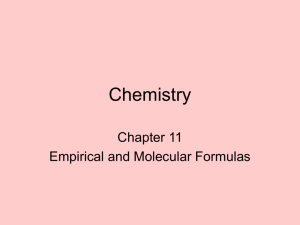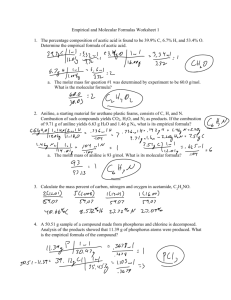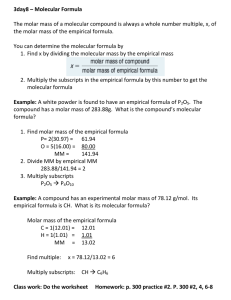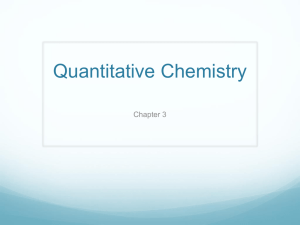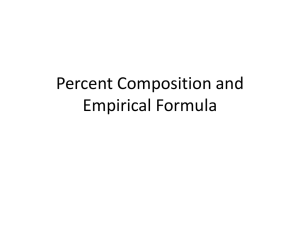1.2 FORMULAS 1. Define MOLAR MASS: a)
advertisement
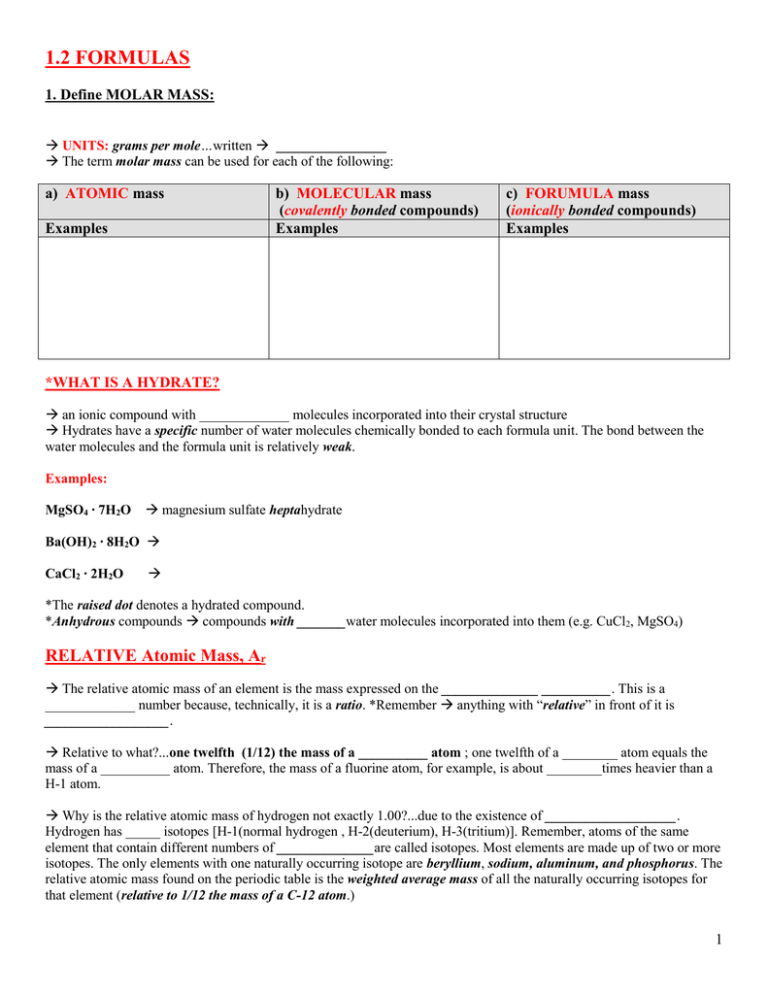
1.2 FORMULAS 1. Define MOLAR MASS: UNITS: grams per mole…written ________________ The term molar mass can be used for each of the following: a) ATOMIC mass Examples b) MOLECULAR mass (covalently bonded compounds) Examples c) FORUMULA mass (ionically bonded compounds) Examples *WHAT IS A HYDRATE? an ionic compound with _____________ molecules incorporated into their crystal structure Hydrates have a specific number of water molecules chemically bonded to each formula unit. The bond between the water molecules and the formula unit is relatively weak. Examples: MgSO4 ∙ 7H2O magnesium sulfate heptahydrate Ba(OH)2 ∙ 8H2O CaCl2 ∙ 2H2O *The raised dot denotes a hydrated compound. *Anhydrous compounds compounds with _______water molecules incorporated into them (e.g. CuCl2, MgSO4) RELATIVE Atomic Mass, Ar The relative atomic mass of an element is the mass expressed on the ______________ __________. This is a _____________ number because, technically, it is a ratio. *Remember anything with “relative” in front of it is __________________. Relative to what?...one twelfth (1/12) the mass of a __________ atom ; one twelfth of a ________ atom equals the mass of a __________ atom. Therefore, the mass of a fluorine atom, for example, is about ________times heavier than a H-1 atom. Why is the relative atomic mass of hydrogen not exactly 1.00?...due to the existence of ___________________. Hydrogen has _____ isotopes [H-1(normal hydrogen , H-2(deuterium), H-3(tritium)]. Remember, atoms of the same element that contain different numbers of ______________are called isotopes. Most elements are made up of two or more isotopes. The only elements with one naturally occurring isotope are beryllium, sodium, aluminum, and phosphorus. The relative atomic mass found on the periodic table is the weighted average mass of all the naturally occurring isotopes for that element (relative to 1/12 the mass of a C-12 atom.) 1 ISOTOPIC ABUNDANCE the relative amount in which each isotope is present in nature e.g. Magnesium has three naturally occurring isotopes. A sample of magnesium is always made up of these three isotopes in the same proportion. Isotope 24 12 Mg 25 12 Mg 26 12 Mg Mg-24 Isotopic Abundance 79% Mg-25 10% Mg-26 11% *Calculate the relative atomic mass of magnesium. *What is Relative Molecular Mass, Mr? ….same as a molar mass calculation (only difference?) *What is Relative Formula Mass? Practice Calculations: 206 207 1. Lead occurs naturally as four isotopes. These isotopes are 204 82 Pb (1.37%, 204.0), 82 Pb (26.26%, 206.0 ), 82 Pb (20.82%, 207.0), and 208 82 Pb (51.55%, 208.0). Calculate the relative atomic mass of lead. (Ans. 207.2 u) 2. Hydrogen is found primarily as two isotopes in nature: H-1 (Ar = 1.0078) and H-2 (Ar = 2.0140). Calculate the percentage abundance based on hydrogen’s relative atomic mass (i.e. the value given on the periodic table). 3. Chlorine exists as two isotopes – Cl-35 and Cl-37. If the average atomic mass is 35.45, calculate the percentage abundance for each isotope. 4. Thallium consists of thallium-203 and thallium-205. Using the value form the periodic table, determine the relative abundance of each isotope. EMPIRICAL FORMULA (“empirical” (Greek = emperirikos) means “by ____________________”) *Empirical Formula defined (___________________ formula) the lowest whole number ratio of the elements in the compound Complete the following table: Name of Compound Molecular (actual) Empirical (simplest) Lowest ratio of Formula formula elements hydrogen peroxide H 2O 2 glucose C6H12O6 *benzene C6H6 *acetylene (ethyne) C2H2 **aniline C6H7N **water H2O *The same empirical formula can represent more than one compound. **Many compounds have molecular formulas that are the same as their empirical formulas. 2 What is the relationship between the empirical formulas of C6H6 and C2H2 and their molar masses? Formula Molecular, C6H6 Related Molar Mass (g mol-1) Empirical, CH Formula Molecular, C2H2 Ratio M .M .Molecular M .M . Empirical Related Molar Mass (g mol-1) Empirical, CH Ratio M .M .Molecular M .M . Empirical *Note that the ratio of the molar masses is the same as the ratio of the subscripts in the two formulas. PERCENTAGE COMPOSITION * Determine the percentage composition(by mass) of : a) water b) carbon dioxide DETERMINING A COMPOUND’S EMPIRICAL FORMULA FROM PERCENTAGE COMPOSITION EXAMPLE: A compound is 17.6% hydrogen and 82.4% nitrogen by mass. Determine the empirical formula of the compound. Steps: Rhyme (memory aid): 1) Percent to Mass 2) Mass to Mole 3) Divide by Small * 4) Multiply ’till Whole 3 MOLECULAR FORMULA *Molecular Formula defined (________________formula) describes the actual number of each element that make up a molecule or formula unit *Being able to determine the molecular formula of a compound is an important skill often engaged by many different kinds of analytical researchers and technicians. (e.g. forensic scientists, sport doping control) *RECALL: Many compounds can have the same empirical formula. *Examples: The empirical formula for all of the following compounds is _______________. Compound Molecular Formula formaldehyde acetic acid lactic acid erythrose ribose glucose CH2O C2H4O2 C3H6O3 C4H8O4 C5H10O5 C6H12O6 *Whole-number multiple 1 2 3 4 5 6 Molar Mass (g/mol) 30.03 60.05 90.08 120.10 150.13 180.16 *The subscripts in the empirical formula are multiplied by this number(i.e. the number in the third column) in order to attain the subscripts for the molecular formula. Determining a Molecular Formula Example: *The empirical formula of butane, the fuel used in disposable lighters, is C2H5. In an experiment, the molar mass of butane was determined to be 58 g/mol. What is the molecular formula of butane? Steps: 1) 2) 3) Determine the molar mass of the empirical formula. Divide the molar mass of the compound by the molar mass of the empirical formula. Multiply all the subscripts in the empirical formula by the number obtain in Step (2). APPLICATION: The Carbon-Hydrogen Combustion Analyzer *Applications forensic science, food chemistry, pharmaceuticals and academic research Allows chemists to determine the percentage composition of compounds that are made up of carbon, hydrogen and oxygen. *How does it work? Relies on the fact that the complete combustion (reaction with __________) of a hydrocarbon yields only two products _____ and _____. The products, CO2 and H2O, are absorbed and then weighed. The percentage composition of the unknown can then be determined. Example: A 1.000 g sample of a pure compound, containing only carbon and hydrogen, was combusted in a carbon-hydrogen combustion analyzer. The combustion produced 0.6919 g of water and 3.338 g of carbon dioxide. a) Calculate the masses of the carbon and the hydrogen in the sample. b) Determine the empirical formula of the compound. 4

